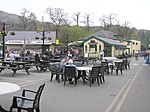Gilfach Ddu
Grade I listed buildings in GwyneddSlate industry in Wales

Gilfach Ddu (also known as the Dinorwic Slate Quarry Workshops) are a series of well preserved Grade I listed industrial buildings built to serve the Dinorwic slate quarry near the Llanberis in Caernarfonshire, North Wales. The workshops are a complex of repair and maintenance buildings, that were built in 1870 to build and maintain the machinery used in the quarry. The complex includes saw sheds, patternmaking shops, a foundry with copula, blacksmiths shops, fitting shops, stores, engine sheds, a canteen, the chief engineers house, a hand operated crane and two waterwheels which provided the site with its power. Since 1972 the buildings have housed the National Slate Museum.
Excerpt from the Wikipedia article Gilfach Ddu (License: CC BY-SA 3.0, Authors, Images).Gilfach Ddu
Geographical coordinates (GPS) Address Website Nearby Places Show on map
Geographical coordinates (GPS)
| Latitude | Longitude |
|---|---|
| N 53.121 ° | E -4.1152 ° |
Address
Welsh Slate Museum
LL55 4TY , Llanddeiniolen
Wales, United Kingdom
Open on Google Maps









